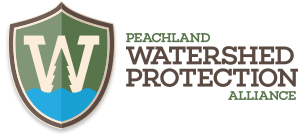by Judy Wyper, PWPA Member
Do you read The Walrus? (https://thewalrus.ca) It’s an independent journalism website with in-depth environmental pieces. The July 2022 issue has a gripping account of BC dams and potential risks to tailings storage facilities (TSFs). It’s entitled “B.C. has a growing mine waste problem.” PWPA has been wondering about the state of the local Brenda Mine site, and had a tour a while back. Fionda’s article is a “mine” of information. She provides links to a July 2022 report by the BC Mining Law Reform group and Skeena Wild, two advocacy groups: Protecting Communities and Watersheds: Risks of Tailings Dam Failures in the Face of Climate Change. That report is well worth reading. It includes links to an interactive map of BC mines with TSFs, including Brenda Mine, with an Extreme rating if its TSF fails: Loss of greater than 100 lives; major environmental/cultural losses; extremely high economic losses.
When the Mount Polley dam failed eight years ago, the Expert Panel’s subsequent report made several recommendations, none of which have been acted on. The recommendations made by BC Mining Law Reform and Skeena Wild repeat some of those recommendations, and the specific one relevant to the Brenda Mine is to give “clear direction on how to manage closed sites that need ongoing inspection, monitoring and maintenance to reduce consequences and failure.” I wondered why the government would need to be asked to do this. Why aren’t these protocols already in place? Who is minding the shop? Of course it made me wonder how the mine has been monitored since it closed in 1990.
Noranda ran the mine, and now Glencore manages the decommissioned site. Their website gives details of the previous and current operations. This is from the Brenda Mine/Glencore website: (https://www.glencore.ca/en/brenda)
The Brenda Mine site occupies a total area of approximately 1,300 hecatres (ha). The mine site encompasses all the disturbed areas of the project, amounting for about 800 ha, including the open pit, the four rock piles, the sites of the two former low grade ore stockpiles, the mill and plant site, service roads and the tailings impoundment area, including the main dam, the tailings pond, the saddle dam and the upper and lower reclaim ponds.
I found maps of the site and the locations of piezometers. These are geotechnical pressure sensors to measure pore water pressure in the ground and would help indicate problems with containment. Permit 263 is included, the extensive agreement of the terms and conditions for Glencore’s management of the site, and dates from 2014. There are links to the monthly newsletters which began in 2000. “In May, 410,547 m3 of water were processed from the tailings pond and discharged into Trepanier Creek, with an annual total of 421,854 m3. Approximately 2,019,200 m3 remain in on site storage for 2022, 1,473,200 m3 from tailings and 546,000 m3 from the pit. The water treatment plant treated water at 170 l/s.” The monthly reports show graphs of levels of molybdenum, sodium, dissolved sulphate, and hardness. These measurements are safely below the BC health guidelines.
On July 27, I watched a Zoom meeting held by the District of Peachland’s Healthy Watershed Committee. In attendance were two Glencore Site Management representatives, Andrew Hallock and Erin Clyde. Also present was Mark Smith, manager for BC’s Tailings Dams Management, from the BC Energy and Mines Ministry. It was an informative meeting. The BC Mining Code has been updated since Permit 263 came into force, requires more frequent reporting, and much of that can involve third party investigators. The reporting requirements seem stringent, but I haven’t been able to locate any of these annual reports online. Without reading the various reports, we are kept in the dark about specific details of mine management.
The meeting ended before there was a chance to ask specific Brenda Mine questions, but the Glencore representatives said they would be happy to answer questions via email. I sent some the very next day and await their responses. I am wondering about the presence of selenium, uranium, and arsenic in the tailings; more information about the piezometers; snowpillow measurements for as many years as they have kept these; alert and evacuation systems; five year reports; annual reports.
As citizens of Peachland, it is in our interests to be as informed about potential hazards as possible. We keep an eye out for wildfires. We watch what is happening in our forests. We try to be proactive. The presence of a decommissioned mine sitting high above us, with a tailings storage facility and complex system of management is not to be ignored. I will keep you posted.
